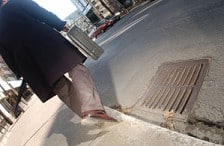More Central Iowa cities form stormwater utilities

As the state dries out from one of its soggiest summers on record, a growing number of Central Iowa communities are imposing fees on businesses and residents to foot the cost of building and maintaining stormwater infrastructure.
A majority of Greater Des Moines cities now assess stormwater utility fees, and among those that don’t, at least a few are considering doing so. Though record rainfall exacerbated many cities’ stormwater problems, a flood of federal clean-water regulations are also driving the trend, officials say.
The city of Urbandale, for instance, began collecting stormwater fees at the beginning of this year. Indianola is in the final stages of approving a stormwater utility that would be effective Jan. 1. Johnston’s city council is currently considering a stormwater ordinance as well. Altoona has also approved a stormwater utility that will begin collecting fees on Jan. 1.
“There are so many regulations for storm water, and they’ve gotten so much more strict, we felt they should be paid for on a direct-cost basis and not through property taxes,” said Altoona Mayor Tim Burget. And like many cities in Iowa, Altoona has battled flooding from unusually heavy rains in the past few years.
As communities grow, they often experience more stormwater runoff problems due to their increasing impervious surface areas.
“I think it’s as much a fairness issue,” Burget said. “Let the areas creating the cost help pay for fixing the problem.”
Most homeowners in Altoona will pay a monthly fee of $3 in the first year, which will increase in 50-cent steps in each of the next four years to $5. By comparison, Altoona’s largest commercial property, Prairie Meadows Racetrack and Casino, will be assessed a total of nearly $34,000 next year, part of approximately $400,000 the city estimates it will collect in 2011.
On the back burner
Stormwater utilities provide a mechanism for cities to pay for stormwater infrastructure improvements by assessing property owners based on the amount of surface area they have that creates runoff. Typically, a city will calculate the average residence’s square footage of roof and concrete surfaces that don’t absorb rainwater and use that equivalent residential unit (ERU) to assess homeowners and businesses. Many cities assume an average of one ERU per residence, and for commercial properties apply a rate to the the actual square footage of impervious surfaces divided by the square footage of the average residential lot.
Iowa communities are “a little behind” other states’ efforts to establish stormwater utilities, said Pat Sauer, stormwater services coordinator for the Iowa Association of Municipal Utilities.
“I would say storm water has been on the back burner for too long for most cities,” Sauer said. She estimates that 26 cities in the state have established stormwater utilities.
Pleasant Hill is among a handful of Greater Des Moines cities that have not instituted a stormwater utility. Russ Paul, the city’s stormwater coordinator, said he has broached the topic with the city council, “but the current council is showing no real interest.” Paul, whose position was created two years ago as part of Pleasant Hill’s streets and utilities department, said he believes a stormwater utility is going to be a necessity for every community.
“As (federal stormwater regulations) get more restrictive, there has to be a way to fund someone to take control of the projects,” he said. “It’s really an unfunded mandate from the federal government.”
Des Moines, among the first cities in the state to create a stormwater utility following the Floods of 1993, will collect about $14.6 million in stormwater utility revenues this year and incur approximately $6 million in costs. Having a stormwater utility has been essential to the city’s ability to mitigate potential flooding damage, said Bill Stowe, Des Moines public works director.
“If we as a city had to rely on general obligation bonds or the general fund and didn’t have a stormwater utility, we would be competing with a number of other priorities,” he said. “This makes very apparent the tie to funding and improvements in protection.”
Des Moines’ monthly fee, currently $7.87 per ERU, is scheduled to increase by 8 percent on Jan. 1 to $8.50 per ERU, the highest of any city in the metro area. Earlier this year, the city issued $19.1 million in stormwater revenue bonds, which are repaid with future revenues from the fees.
“There’s no question that there are a number of federal clean water requirements that drive this,” Stowe said. “But also a significant portion of it is not only water quality but also water quantity. We’re a low-lying city at the confluence of two rivers in a significant watershed, so flood protection is a primary piece.”
The Des Moines City Council is likely to consider a further increase within the next year, Stowe said. “We’re in the process of trying to come up with the appropriate rate increase,” he said.
Money mover
Chuck Becker, an environmental attorney with the Belin McCormick law firm in Des Moines, said the recession has contributed to more interest by cities in establishing stormwater utilities. “Overnight, cities passing these stormwater ordinances are going to find themselves in better shape financially,” he said.
“It’s a movement of money, but one that I think is sensible,” he added. “The trick with stormwater utilities is that you have to plan ahead. A city may not need it now, but in five years it will.”
About seven years ago, Becker represented the Bell Avenue Business Center in a successful appeal of those fees. The judge ruled that the business park did not receive any benefit from the city’s storm sewer infrastructure because storm water drained from the property directly into Gray’s Lake.
Since then, “some businesses have objected, but not to a great degree,” he said. “The reason is that it’s easy to see that you have to pool enough money on something like this to effectively address, just like streets in many ways.”
Becker said if the U.S. Environmental Protection Agency proceeds with rules that create “drainageway districts,” cities could face significant increases in regulatory costs. “But at least the cities with stormwater utilities will have the mechanisms in place to address it.”
The $500,000 Urbandale expects to collect in the first year of its program is just “making a dent” in covering stormwater project costs, said David McKay, the city’s drector of engineering and public works.
Altoona strives to collect half of its revenue from residences and half from commercial properties.











